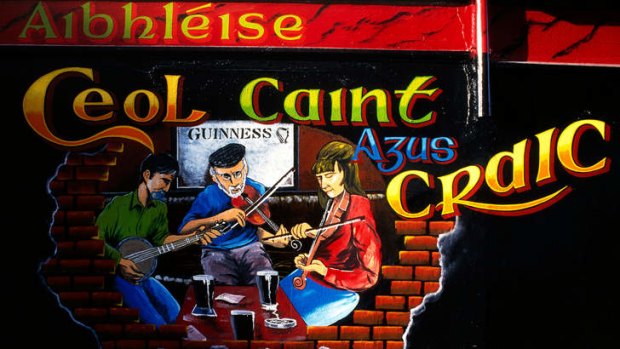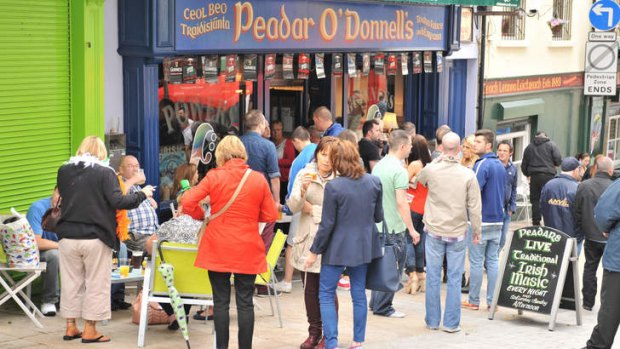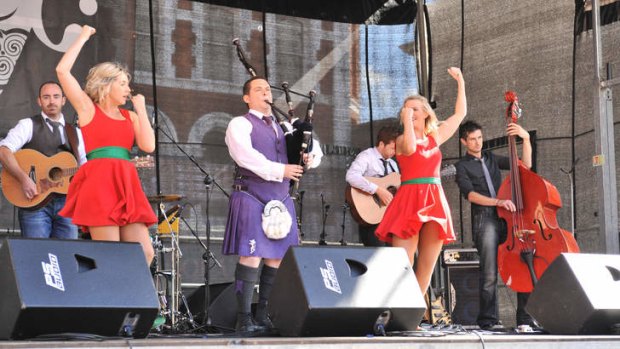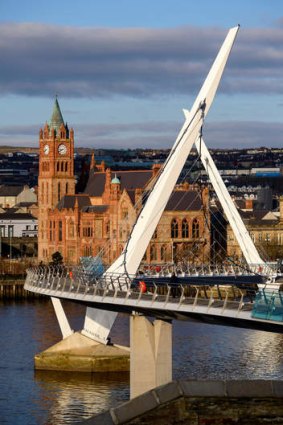
Pub art in Derry.Credit: Alamy
Derry is putting the Siege, the Troubles and Bloody Sunday behind it, writes Ben Groundwater.
"Just say yes."
The campaign slogan was a telling one. Derry wanted to become Britain's inaugural City of Culture, and it was running on the word "yes". Just say yes. It was telling because the northern Irish city, undoubtedly rich with culture but also suffering more than its share of problems in the past, had previously been defined far more by the word "no".

Fleadh Cheoil festival.Credit: Alamy
You can still see the evidence of no today. It's there stencilled on a wall on the city side of Derry, in the small Protestant enclave with its red, white and blue-striped pavements and its flying Union Jacks. "No Surrender", the graffiti proudly proclaims, the slogan Derry was once so well known for.
The surrender refers to an infamous siege; an event of more than 300 years ago that shaped the city Derry would become, and continues to define some of the characters within its ancient walls. It was a battle between foes now so familiar - Catholics against Protestants, nationalists against loyalists - that was marked by a group of boys who barricaded the city gates and yelled, "No surrender!" sparking a three-month standoff. The die was cast; the sides were picked.
Fast forward through Derry's history - that you can still feel today as you wander the tops of its walls in a light Irish drizzle - and the Siege keeps tugging at you, reminding of its presence in the city's psyche. It's there in the formation of the Apprentice Boys Club, dedicated to commemorating those lads who closed the gates. It's there in St Columb's Church, the city's oldest building and shelter during the Siege. It's there in the sectarian violence of the early 20th century. It's there in the "Troubles" and in Bloody Sunday.

Traditional performers.Credit: Alamy
But Derry is seeking to put all that behind it, and that's where the word "yes" comes in. Derry entreated voters for the City of Culture title to look beyond the troubles and the violence and say yes to the city as a hub for culture - and they did. This year, therefore, is a celebration of all that's good about life in Derry, from art and music and dance and comedy, to historic monuments and famous sites. (There's a slightly cheeky dual meaning to "Just say yes", too - Derry residents are famous for a lingual quirk where yes is used in place of hello as a greeting. Wander the city's streets and you'll hear people meeting friends: "Yes, John!" Or, "Yes, Shona!" Derry residents have been saying yes for a long time.)
Nowhere in the city is more indicative of Derry's shift from conflict to culture than Ebrington, the former British army barracks. Once a symbol of the division in the city, a fortress for nationalists gazing across the river at the republican enemy, the area has been transformed into an entertainment precinct hosting plenty of the year's celebrations.
The soldiers have gone from the parade ground, which has been replaced by an open-air concert space. The barracks themselves have become a maritime museum, and the venue for the Turner art prize exhibition, which begins in November, marking the first time the prestigious award has been hosted outside England.

Calm at last: Hands cross the Divide sculpture.Credit: Corbis
Ebrington is also the landing point of one of Derry's newer monuments, the Peace Bridge, a pedestrian thoroughfare as heavy with symbolism as it is with steel. The bridge acts as a link between the largely unionist "water" side of Derry and the nationalist "city" side, areas that have long been separated by ideology as much as geography.
The new bridge, with large struts meant to signify outstretched arms, is bustling each day with commuters and joggers, dog walkers and tourists. Today, as the rain falls in great sheets across the Foyle River, I'm making my way across to the city side of Derry, ready to explore permanent attractions featured in the City of Culture celebrations.
The Tower Museum is a natural first port of call, as it sits just within the city walls overlooking the Foyle and the Peace Bridge. It also hosts the permanent Story of Derry exhibition, providing the perfect introduction for visitors keen to understand the myriad factors that went into the formation of this amazing city.

The Peace Bridge over the Foyle River.Credit: Alamy
From the introduction of Catholicism to the "planting" of Scottish farmers, the building of the walls and the Siege, right through to Bloody Sunday and the British government's eventual admission of guilt, it adds texture and colour to the cobbled streets and the people who walk them.
Back on those streets, it's time to climb the stairs of the city walls - built 400 years ago and completely intact - and walk their 1.5-kilometre circumference, taking in views of the Foyle and the green hills that ring the city, past the Protestant enclave (and a shopping mall) before circling around to view Bogside, site of the Bloody Sunday massacre. Here you can make a quick detour to the Apprentice Boys Club, dedicated to honouring those boys who slammed the gates and yelled, "No surrender!" to begin the Siege.
That, of course, was more than 300 years ago, but they don't readily forget around here. Twice a year the modern-day boys march through Derry's streets to commemorate the Siege, and a quick wander through the club's dark halls reminds you that the past is never far gone in Derry. Check out the huge effigy of "Lundy the Traitor", a rendering of Robert Lundy, the loyalist governor who betrayed his troops during the Siege, which is ceremonially burnt to ashes every year.
There are two sides, of course, to every story, and two sides to every conflict. Pass under the walls and wander down the hill to Bogside and all of a sudden you're deep in nationalist territory, where wounds are still raw, but peace has been made.
The first things you notice are the murals, bright paintings that cover huge walls, the living history of a troubled area. There's the rendering of man with a sledgehammer; a young girl with a machinegun; a dove meant to signify peace; and the most famous of all, black text on a white wall reading "Welcome to Free Derry".
To find out what it's all about you only have to turn a corner and visit the Museum of Free Derry. Run by the brother of a man killed on Bloody Sunday, it details the events of that day and those that led up to it. It's confronting - the jacket worn by one of the victims is there, complete with bullet holes and bloodstains. Sound from the day British forces opened fire on unarmed protesters plays on a loop in the background. But there's also the feeling that this is presented more out of respect than anger; that Derry really is moving forward from its troubled past.
For that feeling to truly sink in, you have to go to where every self-respecting resident of Derry, regardless of religion or creed, likes to go: the pub. This is Derry culture at its finest, and the place most visitors will enjoy the city's year as cultural capital. There's no sign of tension here, just joy of the "craic", the search for a good time.
The classic destination is Peadar O'Donnell's, the most Irish of Irish pubs, host of live bands and spontaneous singalongs among punters who bring their own instruments and stay long past the official closing hour. You can't help but make friends here, yelling conversation over live music and the clink of pints of Guinness.
Culture never seemed like more fun, and it can be hard to leave at night's end. So when someone offers you another pint, when they're desperate to keep the craic going, willing you to stay on for an evening that may never be called a night, there's a certain slogan worth bearing in mind: just say yes.
The writer was a guest of Visit Britain.
ABOUT THE WRITER
Fairfax blogger and columnist Ben Groundwater has been travelling his entire life, and writing about it for the past 10 years.
TRIP NOTES
MORE INFORMATION
GETTING THERE
Emirates Airlines has a fare to Dublin for about $2105 return from Sydney and Melbourne, including tax. Fly to Dubai (about 14hr) and then to Dublin (8hr 20min). Phone 1300 303 777, see emirates.com /au. Buses run from Dublin Airport to Derry taking about three hours. See buseireann.ie.
STAYING THERE
The City Hotel has spacious rooms right by the city walls in Derry for $110 a night. See cityhotelderry.com.
PUBS WITH THE BEST CRAIC IN TOWN
MASONS
This no-frills pub is known for its rock-centric live music but also hosts comedy nights, jam sessions, and even karaoke. It attracts a student-heavy crowd, and the bartenders pour a mean pint of Guinness.
SANDINO'S
Famous for attracting a more alternative, left-leaning crowd synonymous with the characters painted on its walls — Che Guevara, Fidel Castro and Cesar Augusto — Sandino's hosts music ranging from Latin and salsa to jazz and traditional Irish, and is always busy.
PEADAR O'DONNELL'S
Even if there's no band booked for the night in Peadar's, there will be live music. Locals usually bring their instruments along for an evening here, and it doesn't take many pints before they're put to good use.
TRACYS BAR
Another local favourite on Waterloo Street — just near Peader's — Tracys is a no-frills Irish pub with a good pint of Guinness and a friendly crowd.
THE RIVER INN
Derry's oldest pub dates back to before the Siege and runs over two levels: the ground floor for typical Irish fare, and the seedier basement level for later in the evening.
Sign up for the Traveller Deals newsletter
Get exclusive travel deals delivered straight to your inbox. Sign up now.